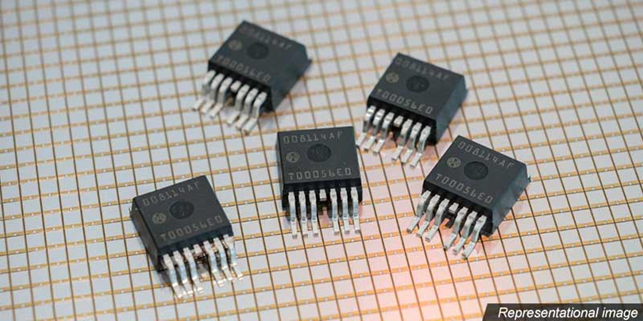- Courses
- GS Full Course 1 Year
- GS Full Course 2 Year
- GS Full Course 3 Year
- GS Full Course Till Selection
- Answer Alpha: Mains 2025 Mentorship
- MEP (Mains Enrichment Programme) Data, Facts
- Essay Target – 150+ Marks
- Online Program
- GS Recorded Course
- Polity
- Geography
- Economy
- Ancient, Medieval and Art & Culture AMAC
- Modern India, Post Independence & World History
- Environment
- Governance
- Science & Technology
- International Relations and Internal Security
- Disaster Management
- Ethics
- NCERT Current Affairs
- Indian Society and Social Issue
- NCERT- Science and Technology
- NCERT - Geography
- NCERT - Ancient History
- NCERT- World History
- NCERT Modern History
- CSAT
- 5 LAYERED ARJUNA Mentorship
- Public Administration Optional
- ABOUT US
- OUR TOPPERS
- TEST SERIES
- FREE STUDY MATERIAL
- VIDEOS
- CONTACT US
HCL–Foxconn 1st Semiconductor chip plant to be developed in Uttar Pradesh
HCL–Foxconn 1st Semiconductor chip plant to be developed in Uttar Pradesh
20-05-2025
- In May 2025, The Union Cabinet approved a ₹3,706 crore joint venture between HCL Group and Taiwanese electronics giant Foxconn to establish a semiconductor assembly and testing facility in Jewar, Uttar Pradesh.
- This project will be implemented under the India Semiconductor Mission (ISM) and marks the 6th project to receive approval under the ₹76,000 crore national programme for semiconductors.
- Out of the total investment, ₹1,500 crore will be provided by the Government of India as financial support through the semiconductor incentive scheme.
- The facility is expected to begin operations by 2027 and will produce display driver integrated circuits (ICs) used in mobile phones, laptops, automobiles, personal computers, and other display-based devices.
- The plant will have a capacity to process 20,000 wafers per month, translating to a production volume of 36 million chips per month.
- Once operational, it is estimated to meet approximately 40% of India’s domestic demand for display driver chips and generate direct employment for around 2,000 individuals.

Background and Strategic Importance
- This is Foxconn’s 2nd major attempt to enter India’s semiconductor manufacturing space.
- In 2022, Foxconn had announced a joint venture with Vedanta to build a semiconductor fabrication facility in India.
- However, due to difficulties in acquiring the necessary technology and disagreements between the partners, the venture was dissolved in 2023.
- The new HCL–Foxconn project is significant as it marks the first chip plant to be developed in Uttar Pradesh under the India Semiconductor Mission.
- It is expected to contribute substantially to India’s efforts to establish a robust and self-reliant semiconductor supply chain.
Importance of the Semiconductor Industry

- Semiconductors, often referred to as “chips,” are critical components of modern electronics.
- They serve as the backbone of digital technology and are integral to everything from smartphones and consumer electronics to cars, aircraft, medical devices, and defense systems.
- Global disruptions, particularly during the COVID-19 pandemic, highlighted the vulnerability of semiconductor supply chains.
- For example, automobile production in several European countries fell by one-third in 2021 due to chip shortages.
- Such incidents revealed the risks of over-reliance on a few countries for semiconductors.
- By 2030, the global semiconductor industry is projected to grow to $1 trillion.
- India’s semiconductor market, which was valued at $15 billion in 2020, is expected to reach $63 billion by 2026, driven by rising demand for electronics, 5G, electric vehicles (EVs), and artificial intelligence (AI).
India Semiconductor Mission (ISM)
- The India Semiconductor Mission (ISM) was launched in December 2021 with an outlay of ₹76,000 crore to build a comprehensive ecosystem for semiconductor and display manufacturing in the country.
- The mission aims to transform India into a global hub for high-tech electronics manufacturing and reduce reliance on imported chips.
Objectives of ISM:
- Develop indigenous semiconductor design and manufacturing capabilities.
- Promote collaboration between industry, academia, and research institutions.
- Promote investment and innovation in semiconductor technologies.
- Create skilled manpower for the semiconductor ecosystem.
- Establish India as a key player in global semiconductor supply chains.
Focus Areas of ISM
The India Semiconductor Mission focuses on the following key areas:
- Integrated circuit (IC) design and fabrication.
- Assembly, testing, marking, and packaging (ATMP) of semiconductors.
- Development of advanced materials and process technologies.
- Design automation tools and intellectual property creation.
- R&D in next-generation semiconductor technologies.
- Skill development to build a specialized workforce.
Approved Semiconductor Projects in India
- Under the ISM, 5 semiconductor and packaging projects have already been approved, in addition to the newly sanctioned HCL–Foxconn project. These include:
- Micron Technology – An ATMP facility in Sanand, Gujarat.
- Tata Electronics and PSMC (Taiwan) – A fabrication facility in Dholera, Gujarat.
- Tata Semiconductor Assembly and Test Pvt Ltd (TSAT) – An assembly unit in Morigaon, Assam.
- CG Power, Renesas (Japan), and Stars Microelectronics (Thailand) – An assembly unit in Sanand, Gujarat.
- Kaynes Semicon – An ATMP unit also in Sanand, Gujarat.
- These projects represent a combined investment of over ₹1.52 lakh crore and are in various stages of construction.
- The first India-made chips from these plants are expected to roll out by the end of 2025.
Significance of Domestic Semiconductor Manufacturing
- Chips are critical to defense, aerospace, and telecommunications.
- Local manufacturing ensures security and control over supply chains.
- India imported semiconductors worth ₹1.71 lakh crore in 2024, 38% of which came from China.
- Domestic manufacturing will reduce this dependence.
- Semiconductor plants provide high-skilled jobs and generate indirect employment in related sectors like logistics, chemicals, and machinery.
- India’s chip consumption is projected to reach 10% of global demand by 2030. With domestic production, India can emerge as an export hub.
- Establishing a chip ecosystem will promote research in AI, robotics, IoT, and advanced electronics.
Challenges for India’s Semiconductor Industry
Despite significant efforts, India faces several challenges in becoming a global semiconductor hub:
- High Capital Costs: A fabrication unit (fab) requires an investment of $5–10 billion.
- Skilled Manpower Shortage: While India has many chip design engineers, it lacks a trained workforce for semiconductor fabrication and operations.
- Infrastructure Gaps: Chip manufacturing demands uninterrupted power and large volumes of ultrapure water—resources not uniformly available across Indian industrial zones.
- R&D Deficiency: India currently lacks advanced research capabilities in semiconductor design and next-generation fabrication technologies.
- Global Competition: Countries like the US, Taiwan, South Korea, and the EU offer more attractive incentive packages and possess mature ecosystems.
Government Initiatives to Support the Sector
To address these challenges and attract investment, the Government of India has launched several supportive schemes:
- Semicon India Programme: Launched in 2021 with a ₹76,000 crore outlay to incentivize fabs, ATMPs, and display manufacturing.
- Design Linked Incentive (DLI) Scheme: Offers financial support to startups and MSMEs working in chip design.
- Production Linked Incentive (PLI): Provides fiscal support for manufacturing and packaging of semiconductors and electronics.
- Skill Development Initiatives: Programs launched in collaboration with IITs and other institutes to train a workforce for the semiconductor industry.
- QUAD Semiconductor Supply Chain Initiative: A multilateral effort to enhance resilience and diversification in chip supply chains
|
Also Read |
|
| FREE NIOS Books | |




